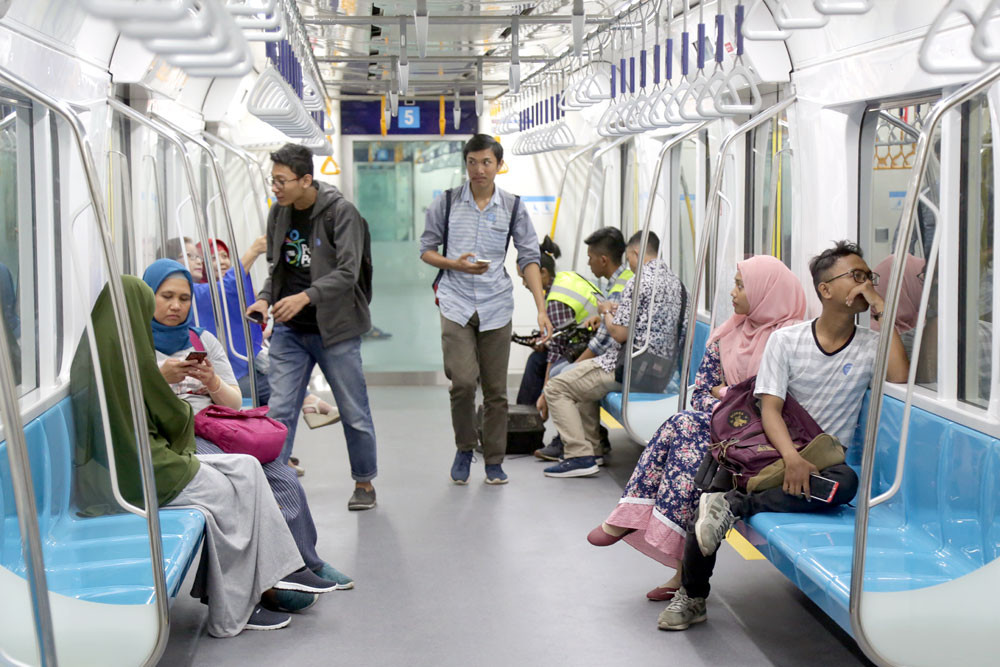Popular Reads
Top Results
Can't find what you're looking for?
View all search resultsPopular Reads
Top Results
Can't find what you're looking for?
View all search resultsImportant things to know before riding the new Jakarta MRT
Here are a few tips for newbie passengers for a maximum Jakarta MRT experience.
Change text size
Gift Premium Articles
to Anyone
T
he euphoria around the opening of the MRT in Jakarta has attracted Jakartans and residents of its satellite cities to try out the brand new mode of public transportation.
Below are a few tips for newbie passengers for a maximum MRT experience as compiled by kompas.com.
1. Know the stations
The MRT has 13 stations from Bundaran HI Station in Central Jakarta to Lebak Bulus Station in South Jakarta. Between the two stations, there are Fatmawati Station, Cipete Raya Station, Haji Nawi Station, Blok A Station, Blok M Station, Sisingamangaraja Station, Senayan Station, Istora Station, Bendungan Hilir Station, Setiabudi Station and Dukuh Atas Station. Passengers are advised to determine which station is the nearest from their starting point and destination as the train fare will progressively increase the further the ride.
2. What payment methods to use
The MRT accepts electronic cash cards issued by banks such as Mandiri’s e-Money, BRI’s Brizzi and Tapcash, BCA’s Flazz and Bank DKI’s Jakcard.
The JakLingko card can also be used to pay for MRT trips.
Another payment method is Jelajah, a payment card issued by MRT Jakarta, sold at ticketing machines and counters at the stations. For a single trip Jelajah, a passenger has to pay Rp 15,000 (US$1.05). The MRT will soon issue a multi-trip Jelajah card for Rp 25,000. The card is returnable to the MRT after seven days of use as long as it's still in good condition.
To obtain the Jelajah card, passengers will have to have to stand in line in front of the counter or ticketing machine. For more convenience, passengers are advised to prepare their electronic money prior to entering the station so that passing through the tapping gate will be a breeze.
3. MRT etiquette 101
During the first run of the MRT trial, several photos of people littering at the MRT Station or sitting on the floor in the station went viral. Photos of those striking a pose by hanging on the train's passenger handles also triggered negative reactions from social media users, most saying that not everyone was aware of MRT etiquette.
The MRT has set several standard regulations on how to behave in the stations or inside the train. One of which is that the MRT does not provide any garbage bins, so passengers are encouraged to manage their trash and not litter.
Passengers are also advised not to run in the station or in the train car, as this can endanger yourself and other passengers.
Standing on the left side of the escalator is advised for those who wish to stand still, as the right side of the escalator is spared for those who want to continue walking.
Elevators are only for pregnant women, senior citizens or passengers with children or heavy luggage.
Passengers are also prohibited from eating and drinking inside the train.
Read also: MRT Jakarta opens at half-price fares for April
4. Know your place
The Jakarta MRT is trying to be an inclusive public transportation mode that is able to serve people of various needs.
The third and fourth car of the train is prioritized for passengers with disabilities, so other passengers are advised to choose the cars accordingly.
There are also priority seats for pregnant women, senior citizens or passengers with children in every car.
5. Ask the officers
Helpful officers are positioned at the stations and inside the train, enabling passengers to approach them should they need information. Passengers are also able to report to these officers should they find any suspicious objects around the stations.
The officers will also help passengers who lose their belongings or if they are victims of crime. (gis/asw)







